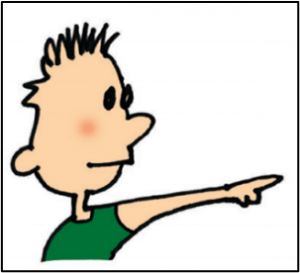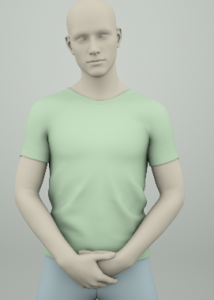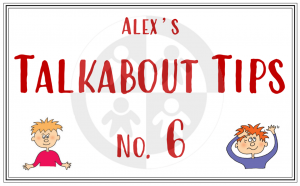Our hands and arms… what are they saying?
What’s in this issue of Alex’s Talkabout Tips?
Welcome to the sixth issue of Alex’s Talkabout Tips. In this issue I am continuing with the topic of body language, and I am going to think about hands and arms. I am starting with this part of our body, because, after the face, our hands are the most spontaneous and informative part of our body and there is quite a lot to say about them.
But before I start, try this… try describing a spiral staircase while sitting on your hands… it’s not easy, is it?! So why are hands so important?
Hands
 Well, we are certainly hard-wired to use our hands when talking and that’s because there are more nerve connections between the brain and the hands than any other part of the body. So, we use our hands to greet people, illustrate a point and generally to express how we are feeling. They are responsible for a lot of the emotional leakage we talked about in the last issue of my Talkabout Tips, and they will influence how we are perceived by others. So, let’s look at a few hand gestures and activities, and I will briefly explain what they show.
Well, we are certainly hard-wired to use our hands when talking and that’s because there are more nerve connections between the brain and the hands than any other part of the body. So, we use our hands to greet people, illustrate a point and generally to express how we are feeling. They are responsible for a lot of the emotional leakage we talked about in the last issue of my Talkabout Tips, and they will influence how we are perceived by others. So, let’s look at a few hand gestures and activities, and I will briefly explain what they show.
The hiding hands
 The first thing to remember about our hands, is to use them. We have more confidence in people who show us their hands and use them when talking to us. So, if someone hides their hands beneath a table or behind a lectern, we generally feel more negative towards them.
The first thing to remember about our hands, is to use them. We have more confidence in people who show us their hands and use them when talking to us. So, if someone hides their hands beneath a table or behind a lectern, we generally feel more negative towards them.
Palms of the hand
 An open palm posture is associated with truth, honesty, submission and being ‘unarmed’. This is one of the most useful behaviours to look for when you are trying to work out if someone is being open and honest. People who are trying to hide something, will hide their palms, either behind their back, or in their pockets or in a crossed arm posture. So, if we want to appear more credible and open, we need to practise using open palm gestures. And interestingly, like the power pose we talked about last time, the more you adopt these gestures, the easier it will be to be honest and credible! This will then encourage others to be open and honest with us. It’s a win-win!
An open palm posture is associated with truth, honesty, submission and being ‘unarmed’. This is one of the most useful behaviours to look for when you are trying to work out if someone is being open and honest. People who are trying to hide something, will hide their palms, either behind their back, or in their pockets or in a crossed arm posture. So, if we want to appear more credible and open, we need to practise using open palm gestures. And interestingly, like the power pose we talked about last time, the more you adopt these gestures, the easier it will be to be honest and credible! This will then encourage others to be open and honest with us. It’s a win-win!
Palms down says something different. This indicates dominance or authority. It is a gesture that is saying ‘there is no room for debate’. However, we may also use this gesture to show assertion and confidence, if we are not being believed.
The pointed index finger
 This is an irritating, aggressive gesture that doesn’t make people feel good and we are basically saying ‘do it or else’. If you are someone who has a tendency to do this, try altering it and squeezing your thumb against your index fingertip in an ‘OK’ gesture. This will make you appear less intimidating, and more thoughtful and focused.
This is an irritating, aggressive gesture that doesn’t make people feel good and we are basically saying ‘do it or else’. If you are someone who has a tendency to do this, try altering it and squeezing your thumb against your index fingertip in an ‘OK’ gesture. This will make you appear less intimidating, and more thoughtful and focused.
The hand clasp
 People who hold hands with themselves while talking are usually telling us that they are in a state of conflict and the higher they hold their hands, the more negative the tension. If we clasp our hands in front of our crotch, this usually signifies nervousness. If you have ever seen me lecture in front of a large audience, look out for this gesture just before I go on stage! I know I do it!
People who hold hands with themselves while talking are usually telling us that they are in a state of conflict and the higher they hold their hands, the more negative the tension. If we clasp our hands in front of our crotch, this usually signifies nervousness. If you have ever seen me lecture in front of a large audience, look out for this gesture just before I go on stage! I know I do it!
The ‘steepling’ hands

 ‘Steepling’ hands means that fingertips are brought together, gently touching each other and our hands remain still. This can be done either in a raised or lowered position. People who adopt this posture are generally seen to be listening to us, and appear more confident. It is a handy thing to remember if you are feeling nervous, and you are worried about your hands shaking. Bring them together in a ‘steeple’ and you will appear more confident. It is interesting to note how many times you see politicians using this gesture!
‘Steepling’ hands means that fingertips are brought together, gently touching each other and our hands remain still. This can be done either in a raised or lowered position. People who adopt this posture are generally seen to be listening to us, and appear more confident. It is a handy thing to remember if you are feeling nervous, and you are worried about your hands shaking. Bring them together in a ‘steeple’ and you will appear more confident. It is interesting to note how many times you see politicians using this gesture!
Hands behind the back
![]() Standing with our hands behind our back shows confidence – we are happy to expose our vulnerable part of our body. However, it is always interesting to see what the hands are doing behind the back! If they are simply clasped together, then this shows confidence, but if one hand is gripping the other wrist, elbow or finger, then we may be seeing someone who is annoyed, frustrated or nervous.
Standing with our hands behind our back shows confidence – we are happy to expose our vulnerable part of our body. However, it is always interesting to see what the hands are doing behind the back! If they are simply clasped together, then this shows confidence, but if one hand is gripping the other wrist, elbow or finger, then we may be seeing someone who is annoyed, frustrated or nervous.
Hands to face, head, or neck
 When we are anxious or stressed, we show several self-comfort gestures that involve touching our face, head, hair, or neck. For example, if someone is anxious, they may smooth their hair on the top of their head or touch their neck (either at the front or massage the back). They may put both hands up to cradle their head or neck to communicate displeasure or extreme anxiety. If they put their hands to support the jaw, then this can indicate that they are listening but may also show boredom, so we do need to look for clusters of behaviours, in particular eye movements (I will talk about that in a later issue). But as a rule, the more the hand covers the cheek and jaw, the more likely they are to be bored. And if someone puts their hand over their mouth, this usually indicates that they disagree or disapprove of something.
When we are anxious or stressed, we show several self-comfort gestures that involve touching our face, head, hair, or neck. For example, if someone is anxious, they may smooth their hair on the top of their head or touch their neck (either at the front or massage the back). They may put both hands up to cradle their head or neck to communicate displeasure or extreme anxiety. If they put their hands to support the jaw, then this can indicate that they are listening but may also show boredom, so we do need to look for clusters of behaviours, in particular eye movements (I will talk about that in a later issue). But as a rule, the more the hand covers the cheek and jaw, the more likely they are to be bored. And if someone puts their hand over their mouth, this usually indicates that they disagree or disapprove of something.
Arms
 Arms are interesting too… they are our own portable defence mechanism. When we were children, we hid behind furniture or our parents, but then we learnt to hide in a more sophisticated way. We withdraw our arms for protection and self-comfort – we put them to our sides or across our bodies – and the message is clear: we disagree with something, we feel tense or insecure, or we have had a negative thought.
Arms are interesting too… they are our own portable defence mechanism. When we were children, we hid behind furniture or our parents, but then we learnt to hide in a more sophisticated way. We withdraw our arms for protection and self-comfort – we put them to our sides or across our bodies – and the message is clear: we disagree with something, we feel tense or insecure, or we have had a negative thought.
There are several ways in which we can cross our arms, and so let’s look at a few of the most common arm positions and what they mean.
The folded arms
 Folded arms usually display some form of discomfort, and we tend to interpret this in others as a defensive or negative gesture. So, if we are talking to someone and they suddenly cross their arms, it is worth considering that they may not agree with what we have just said, especially if it is accompanied by a more closed facial expression. Look also for tension in the hands – maybe they are gripping their upper arms, or their fists are clenched. This can mean extreme anxiety, or stubbornness or even hostility.
Folded arms usually display some form of discomfort, and we tend to interpret this in others as a defensive or negative gesture. So, if we are talking to someone and they suddenly cross their arms, it is worth considering that they may not agree with what we have just said, especially if it is accompanied by a more closed facial expression. Look also for tension in the hands – maybe they are gripping their upper arms, or their fists are clenched. This can mean extreme anxiety, or stubbornness or even hostility.
Of course, you may like to stand with your arms crossed – but it is important to remember what signals you are giving off and if you want to be seen as approachable, it is best to learn to unfold them.
The partial arm-cross or ‘broken zipper’ position

 Both of these postures indicate a lack of confidence. We are providing a partial barrier which makes us feel better. Women are more likely to use the partial arm-cross and men, the broken zipper position. We may also see people try to disguise their anxiety by crossing their arm over their body to straighten a watchstrap, check their wallet, check an earring, and adjust a shoulder-bag. All of these are displacement activities, that we talked about in the last issue, and are helpful to make us feel protected and comforted.
Both of these postures indicate a lack of confidence. We are providing a partial barrier which makes us feel better. Women are more likely to use the partial arm-cross and men, the broken zipper position. We may also see people try to disguise their anxiety by crossing their arm over their body to straighten a watchstrap, check their wallet, check an earring, and adjust a shoulder-bag. All of these are displacement activities, that we talked about in the last issue, and are helpful to make us feel protected and comforted.
In summary…
So, in this second issue about body language, I have talked about why it is important to understand what our hands and arms are communicating, and I’ve also given you a few things to look out for when talking to others. In the next issue, we will think about our feet, our legs and how and where we sit and stand!
As always, this is just the essential bits! You can read more about all of this in my book ‘Social Skills: developing effective interpersonal communication’(Kelly, 2019).
Please do comment on Facebook or share this with others. If you would like to be added to my email distribution list, please contact me through the website, email me directly or PM me.
Thanks for reading!
alex@alexkelly.biz






